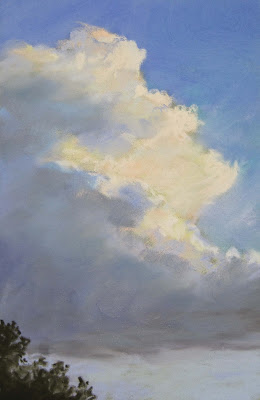 |
| 9” x 12”, 30 minutes |
I’ve been teaching for many years now and very few people have come to me to ask how they could become tighter painters. Far more often they ask what they can do to loosen up and be free, not constricted by tight realism and a slavish adherence to detail.
This exercise will help you relax and paint a little faster. It limits the amount of time you have to paint, making you move faster and without inhibition, as well as limits the palette of colors, which forces you to be creative.
Start with a smaller piece of paper. This small size seems to allow you to let go a bit more easily since you aren’t filling up a huge piece of paper. A smaller paper also allows you to move more quickly without getting bogged down. I usually suggest a 9x12” or smaller size.
If you’re working on Wallis or another sanded paper that has no color, toning is a good idea. It makes the first marks on the paper, which frees you of “white canvas syndrome” and gives an overall color to the paper that you can use with a limited palette. You may choose one of the colored papers such as Art Spectrum, La Carte or Pastelmat.
Any subject matter will do for this exercise, but clouds and skies are particularly suited to it. The idea is to paint fast and furious without a lot of detail, which works nicely in the sky. The palette of colors found there is already somewhat limited, and clouds lend themselves to looseness.
Prepare ahead. Tape your paper to the board, clip your photograph on the board where you can see it and take out a white paper towel for your palette of pastels. As in the last chapter, devoted to limiting your palette, carefully choose only 10 colors. Use dark, medium-dark, medium, medium-light and light colors, based on the photograph. Lay out the colors you’ve selected on a paper towel and put away your palette.
Find a timer, preferably one that has a loud alarm that will stop you in your tracks, and set it for 20 minutes. Begin with an extremely fast sketch that only locates the horizon line and the major elements of the composition. There’s no time for details.
Work all over the painting with the colors so that you structure things altogether at one time, relating all the elements to one another. Don’t start with any detail. If you begin to put in too many details you’ll slow down too much. You must keep moving. If you don’t have the right color, layer the ones you do to achieve the right value instead. Make use of the different colors and values on hand to make new ones, layering and blending them.
Keep the timer where you can see it so that you’re aware of how long you have left to paint. This is a sprint, so go all out. Abandon yourself to the color and mood, dashing in streaks and smoothing down swaths of colors all over.
When the timer sounds, lay down your pastels. Now step back and analyze what’s happening. Look for the accidental things that thrill you and for those things that are working. Ask yourself if you missed one or two colors, perhaps colors you didn’t choose or missing values.
Choose only one to two more colors and add them to your limited palette. Set the timer for an additional 10 minutes and get going. Again, move fast, not letting up for details. Work right up until the timer sounds, then lay down your pastels.
If you’re like most of us, you’ll find things you like about this fast little painting, and some things that displease you. Sometimes it takes a little practice to loosen up and accomplish much in just a half hour, so practice! Set a goal for yourself, perhaps to paint 10 of these little ones in a week. This will give you the motivation to keep working.
When you have a small body of these paintings lay them out together and analyze what’s working and what isn’t. There’s a lot to be learned from this.
• Stop criticizing what doesn’t work because you were moving fast, and instead look for trends, for those things that happen repeatedly that please you.
• Put them in order of your own personal preference and ask yourself why you chose this order.
• Find the things in each one that works and ask why. Use corners to crop down to the area that is spontaneously successful and think about what happened there that is good. Did you use a certain kind of stroke, a particular set of color layers, or another element that works? Be specific.
• Evaluate the things that happened that pleasantly surprise you with their clarity, despite the messy, spontaneous strokes.
Then go paint some more.
 |
| 6" x 9", 20 minutes |
 |
| 6” x 9”, 20 minutes |





No comments:
Post a Comment